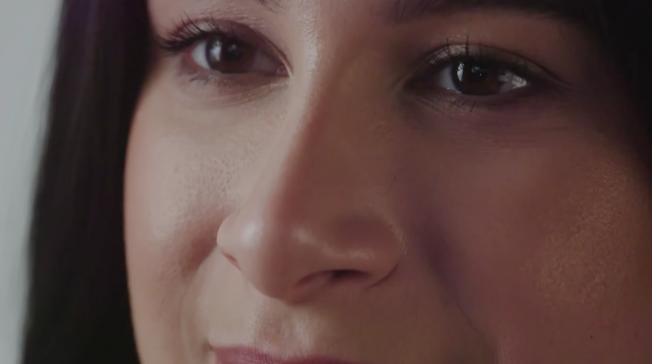![]()
If waiting for the next installment of Black Mirror is too taxing for you, fill your soul's vacuum with the latest installments of Dell's campaign "Future Ready."
Created by Young & Rubicam New York, in partnership with Framestore—responsible for a lot of the cool stuff you see in movies—the episodic campaign follows one family's effort to secure a heart transplant for their young daughter.
Unlike in Black Mirror, though, the technology you see is more benign and empowering than existentially misery inducing.
The work builds on "Beat Again," which appeared last year and followed the family to the hospital. Cool probable technology included a haptic magazine, vital statistics that scroll across the daughter's arm, and responsive holograms that enable the doctor to monitor her heart from all angles during surgery.
This time, two episodes tell stories around that critical moment, giving Dell the chance to show off how technology can improve our lives outside the emergency room, too.
"Night Before" is about the doctor, whom we see interacting with his son online as his plane descends on the city. Most of the rest of the video focuses on the comforts of his hotel stay, which is so intuitive that even we feel more relaxed just by watching—a nice situation to be in when you've got life-changing surgery to conduct.
Dr. Ajay's data "arrives before he does," enabling the front desk to welcome him by name and provide a real-time view of his room options. He orders a sushi dinner from a holographic lazy Susan, checks the weather on the back of his hand, and gets live updates on a heart match without even having to put his chopsticks down.
Future folks live pretty. Facebook can't even remember where we went to college.
"First Day Back" follows the little girl's journey back to school after her successful transplant (good thing Dr. Ajay was well rested!). Technology helps her gauge the distance of her school bus and check her vital stats (again on her arm, via a slim metal bracelet that's infinitely more elegant than a Jawbone, Fitbit or Apple Watch).
We also get nifty shots of how it'll make school feel less like an episode of Prison Break. As she walks by a classroom, a teacher with the full attention of adoring students launches a rocketship into the ether. "That's so cool!" one kid says, and the beaming educator laps it up.
When the girl enters her own classroom, a "Welcome back!" message swathed in balloons shoots up on the wall directly facing her, and her peers and teacher surround her with open arms. (Clearly education is better funded tomorrow than it is today.)
"We embarked on the journey over a year ago to tell the story of a young girl who was awaiting a heart transplant, and that story resonated with so many people," Dell head of global brand Liz Matthews says in a behind-the-scenes video (below).
"We took a step back and said, How do we continue that story and build even more around not only her and her family, but the doctor who actually performs the transplant, the teachers, educators and her friends who are there for her when she goes back to school?"
The videos follow a very tight script: Smarter use of data, the value of the cloud, and the power of Dell's network are emphasized in that order as each story spins out, guiding viewers to a final question: "Is your business future ready?"
It's probably best not to dwell on this question if you're still defining your Twitter tone of voice or trying to wrangle something coherent out of Snapchat. But the optimism of the work is infectious and heartening: We focus a lot on the difficulty of change, and on which of our jobs robots will destroy on their inevitable path to enslaving mankind.
"Future Ready" is not so much a message as a calming reminder: With every disruptive advancement of technology, the value of what makes us human has actually risen, and the disruptions awaiting us will be no different.
Technology is only partly defined by the efficiencies it affords us (though this gets a disproportionate amount of attention). What gives it a soul, and a place in our lives, is in the small graces it enables us to pass on: Less stress, more connectivity, and the ability to prioritize what matters to us.
Those small graces are our responsibility—and if Dell is effective at showing off its data, cloud and network ambitions here, it's because it conveys its faith in our ability to rise to that standard, both in leisure and where it counts most: The same technology that makes Dr. Ajay's holographic sushi menu possible also proves critical to the success of a child's heart transplant, and both contibute to our sense that the world depicted here is, indeed, a better one.
Check out the behind-the-scenes video below:
CREDITS
Client: Dell
Karen Quintos – Chief Marketing Officer at Dell
Elizabeth Matthews – Executive Director Corporate Brand
Juan Carlos Gama – Marketing Director Corporate Brand
Creative Agency: Y&R
Leslie Sims – Chief Creative Officer, Y&R
Christian Carl – Global Executive Creative Director, Y&R
Production
Bobby Jacques – Senior Content Producer
Planning
Joe Rivas - EVP, Global Client Leader, Strategic Planning
Jenna Rounds – Strategy Director, Planning
Account / Project Management
Diana Melton – Director of Marketing, Y&R
George Rainaldi – Assistant Account Executive, Y&R
Andrea Rey – Senior Project Manager, VML
Production Company: Smuggler
Executive Producer: Drew Santarsiero
Director: Henry Alex Rubin
DP: Janusz Kaminski
Production Designer: KK Barrett
Editorial Company: Cutters NY
Editor: Steve Bell
Color: Lez Rudge – Nice Shoes
Mix: Tom Jucarone – Sound Lounge
EFX: Framestore NY
Exec Producer: Dez Macleod-Veilleux
Creative Director: Gigi Ng and Akira Thompson
VFX and Compositing Supervisor: Gigi Ng
Design Supervisor: Akira Thompson









































